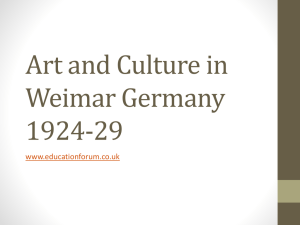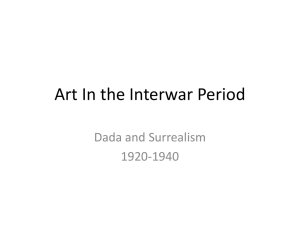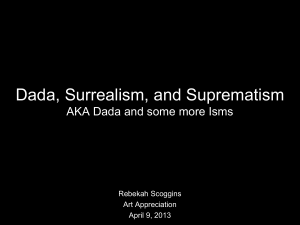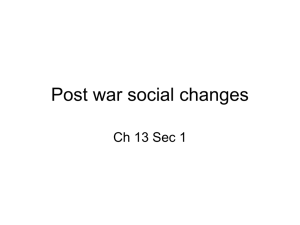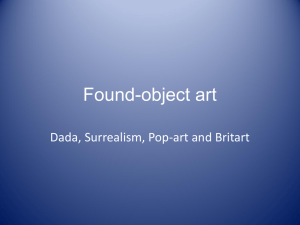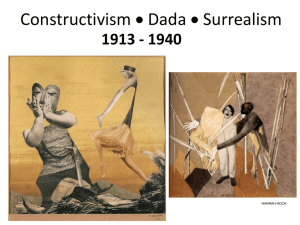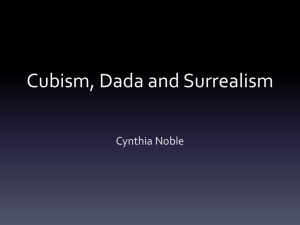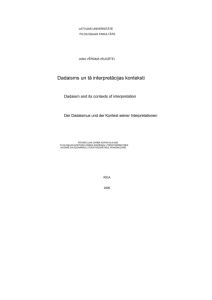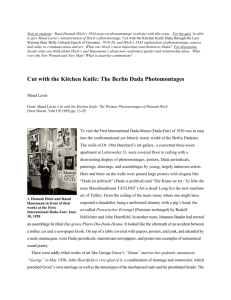Dadaism in Berlin
advertisement
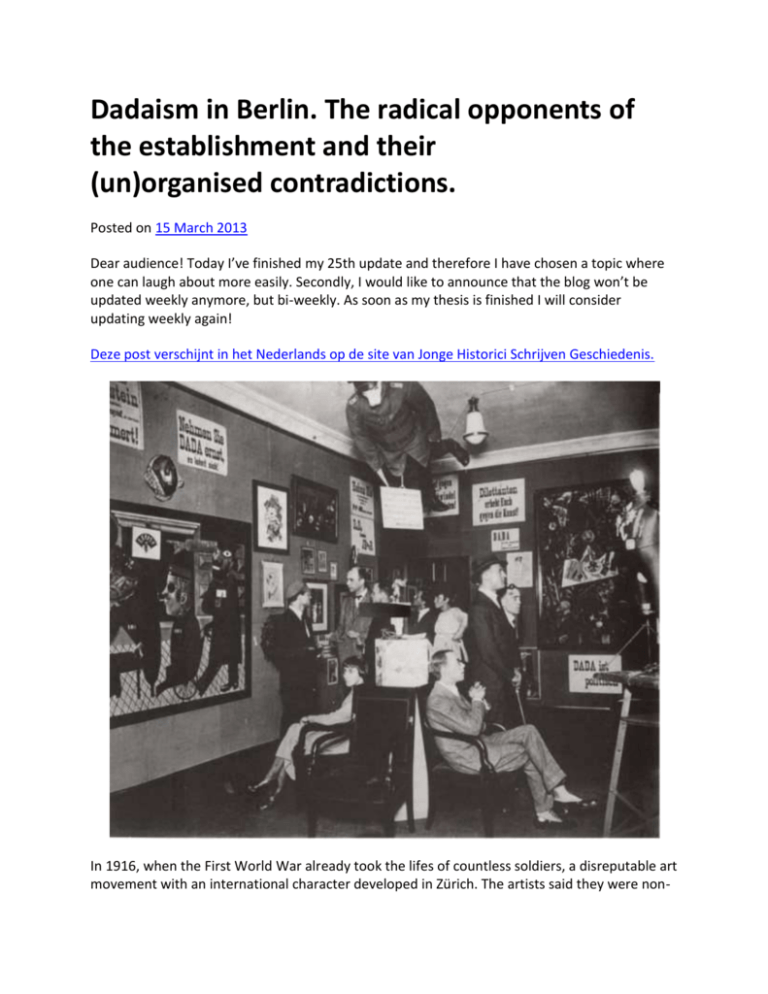
Dadaism in Berlin. The radical opponents of the establishment and their (un)organised contradictions. Posted on 15 March 2013 Dear audience! Today I’ve finished my 25th update and therefore I have chosen a topic where one can laugh about more easily. Secondly, I would like to announce that the blog won’t be updated weekly anymore, but bi-weekly. As soon as my thesis is finished I will consider updating weekly again! Deze post verschijnt in het Nederlands op de site van Jonge Historici Schrijven Geschiedenis. In 1916, when the First World War already took the lifes of countless soldiers, a disreputable art movement with an international character developed in Zürich. The artists said they were non- conventional and that they opposed all traditions. They legitimised their revolutionary opinion by the aversion of WWI and it had anarchistic characteristics. This movement called itself Dada – an innocent word for likewise baby’s. Within a few years, many Dadaist circles were found in other cities such as Cologne, Paris and New York. Above all, it was in Berlin where the Dadaist group became the most political and radical. How did the Dadaist movement in Berlin develop in this specific way? How and where in Berlin have the Dadaists stated their art? And how much of this can we see nowadays? In January 1917, Richard Huelsenbeck moved from Dadaist Zürich to Berlin. He didn’t establish a Dadaist art movement in this city before January 1918. Then, Huelsenbeck speeched in the art gallery of Israel Ber Neumann at the Kurfürstendamm. In the manifest which he wrote afterwards, Huelsenbeck started with the announcement that art should be timeless and universal. Thereafter, Huelsenbeck positions Dada against other art movements – and claims that Dadaism is against theories, the press and advertisement. As well the speech as the manifest ended with the statement that one should also oppose this manifest to be a Dadaist. The speech and the following manifest were a huge succes and motivated artists and writers to join the founded Club Dada. Besides Huelsenbeck, the most active Dadaists in Berlin were George Grosz, Raoul Hausmann, Johannes Baader, John Heartfield and Hannah Höch. After Huelsenbeck tried to sell the Dada manifest in April 1918, the provocative items were confiscated by the police – and Raoul Hausmann was imprisoned. The movement couldn’t recover from these restrictions before Germany became a Republic in November 1918. In the meanwhile, the ballotage to become member of Club Dada became even harder than at all civil societies in Berlin. This huge paradox was still acceptable for the artists since being selfcontradictive was in accordance to the last statement in the Dada manifest. In the Weimar Republic, Dada still politicised the art movement explicitly and opposed the Weimar government, the military, conservative lobbies and the bureaucracy. The Dadaists developed the Dadaistischen Zentralrat der Weltrevolution (Dadaist central union for the world’s revolution). In the meanwhile, the Dadaists developed an office for revolutionary or seperatist groups who want to become a state on its own – which was a painful critique on the imperfection of the League of Nations. The Club Dada sended letters to politicians to exclaim the anarchist revolution. Although Dada as a movement had no ties with any political party, George Grosz and John Heartfield became members of both the Kommunistische Partei Deutschlands (KPD, the German Communist Party) as Club Dada. It is likely that Grosz and Heartfield were the most radical opinionated within Club Dada, seen they changed their names (Groß and Herzfelde) to the tongue of ‘the enemy’. Nevertheless, Gertrud Alexander – an editor of the KPD’s newspaper Die Rote Fahne (The Red Banner) – forbade the two Dadaist artists to call themselves communists. It shows that these two Dadaists were too radical and too different for the most revolutionary party which Germany had. In despite of their critique on all artistic traditions, the organisation behind Dadaism took over the form of many other avantgarde movements. They published manifests, magazines and organised exhibitions. The many manifests and magazines which had a short life, such as Jedermann sein eigener Fussball (Everyman His Own Football) which was released once only in February 1919. The Dadaists were motivated to write this (heavily illustrated) magazine after the surpression of the Spartacist uprising in January the same year and the following death of KPD’s prominents Rosa Luxemburg and Karl Liebknecht. The Sozialdemokratische Partei Deutschlands (SPD, the German socialdemocratic party) felt it was too heavily attacked by Jedermann sein eigener Fussball and illegalised it. All the Daistic manifests and magazines were published by the Malik-Verlag, which was founded in 1916 by John Heartfield’s brother Wieland Herzfelde. From April 1920 till December that same year, the Malik-Verlag even had a Dada department. During the active years of Club Dada, the office the Malik-Verlag was located at the home of Herzfelde at the Kurfürstendamm 76. The organisational height took place in the summer of 1920, with the Erste Internationale Dada-Messe (First International Dada Exchange). The exhibition took place in two rooms of the Galerie Dr. Otto Burchard at the Hinterhaus (back parcel) of Lützow-Ufer 13 in Berlin-Tiergarten. The catalogue shows that 174 objects were presented at the exhibition, made by 27 Dadaist artists from all over the world. Hausmanm, who had talked to the press and could predict their critical opinions, wrote parodies of the reviews in the catalogue. These parodies basically told the reader that Dadaism was based on bragging and a visit to the exhibition is not worth it. Hausmann was right after all, since Kurt Tucholsky wrote in the Berliner Tageblatt “Wenn man abzieht, was an diesem Verein Bluff ist, so bleibt nicht so furchtbar viel.” (“When one reveals the bragging in this fellowship, there isn’t much left”). The most famous object of the Erste Internationale Dada-Messe became the Preußischer Erzengel (Prussian Archangel) – a dummy wearing the uniform of a military officer and a pigs mask. Its creators, Heartfield and Rudolf Schlichter, were accused for insulting the Reichswehr (the army) – as were Georg Grosz, Johannes Baader and Otto Burchard for their objects. Although these convictions were celebrated as a prove that they could still provoke the authorities, only Grosz and his publisher were convicted and forced to pay 300RM (Grosz) and 600RM (the Malik-Verlag). The Erste Internationale Dada-Messe wasn’t only the movement’s peak, it was followed by its downfall. Tucholsky and other critics were right when they said that the movement is based on being loud. Throughout the years, the Dadaists had to radicalise their statements to cause the same effect as before. Even worse was that many critiques didn’t look up from the provocations anymore. Slowly, Dadaism was considered as a necessary artistic phase – as the many other avantgardist groups. Within Club Dada, there were often arguement with each other and the artists continued their own path again solely. In a way, the Dadaists were too unorganised to even work for Club Dada. The Malik-Verlag stopped the Dadaist department in December 1920, though intensive business were still done with Georg Grosz. When the nazi’s took power in 1933, Dadaism was attacked by the state again. Various Dadaists, among them Georg Grosz and Raoul Hausmann, left nazi-Germany and went into exile. Generally, their art was confiscated by the Nazi regime and sold to foreign art dealers – or it was burned. Some of Dada’s art made it to the infamous Entartete Kunst (degenerate art) exhibition in 1937, nazi’s wanted to prove their artistic superiority and expose ‘wrong’ art to the audience. A ‘Dadaismuswand‘ (‘Dadaist wall’) with objects and paroles from Dadaist artists was build. The objects were confiscated from both musea and private collections. In a paradox way, it was a succes for Dadaists to be hated by the petty regime. Although Dadaism was clearly influential before WWII already, one could say that it came to a modest revival since the Fluxus movement in the 1960s. Though I have to be careful with making huge statements about art, I am told that the concept behind an artwork is considered to be more important than the technique ever since. So to speak, there is no doubt that Dadaism belongs in the educational books for high-school pupils – although it is generally announced as a type of ideological art movement which was typical for its time. The nihilist critique which Club Dada had on the society with its violent army, false art movements and politics are considered to be outdated. In the meanwhile – the works of Grosz, Hausmann, Höch and Baader made it till the most established musea such as the Berlinische Galerie (Berlin), Tate Modern (London), the Museum of Modern Art (New York) and the Musée National d’Art Moderne (Paris). Georg Grosz is given a memorial stone at his former house in Berlin-Wilmersdorf, where he lived for five years before he fled to the USA. Another stone in dedication of Grosz is developed at the place where he died, at the Savignyplatz. Though, on this memorial stone he is not remembered as a prominent Dadaist. Hannah Höch is also given a memorial stone in front of her house in Berlin-Heiligensee. More spectacular is the statue which is dedicated to Höch, in the park next to the Tegeler See. The monument is named ‘Der archaische Erzengel von Heiligensee‘ (‘The archaic archangel of Heiligensee’) is revealed in 1989 to honour the 100th birthday of Höch. Other Dadaists, such as John Heartfield, Raoul Hausmann and Johannes Baader are not given a public memorisation as a Dadaist. Wieland Herzfelde, the publisher of the provocative manuscripts, was given a memorial stone at his former house in 1996. Since 2008, a memorial stone remembers the location of the Malik-Verlag at the Köthener Straße – although this was not the location of the publisher when the Dadaist manuscripts were printed. At the original location of the publisher (Kurfürstendamm 76) there is now a house which is too new to be the original house. The location of the Erste Internationale Dada-Messe has also been drastically changed. Probably it is bombed in the Second World War, before it became a parking lot and the back part of a senior house. Taken everything into account, the remembrance of Berlin’s Dadaist movement is quite modest. With the exception of a few memorial stones and dedications to the artists, there is not much remembrance in public space. As far as there are memorials, it seems to be more a dedication to the specific artist than to the Dada movement. No memorial stone explains how political motivated Berlin’s Dada movement was and through which public atmosphere the Dadaist movement it struggled. Perhaps it isn’t unusual for an art movement, the artworks and the artists to be remembered in the private sphere – which generally is a museum. Perhaps it is a relief for the Dadaists that their objects haven’t been worked out as statues so far. Or would they think it is time for a little contradiction again?


